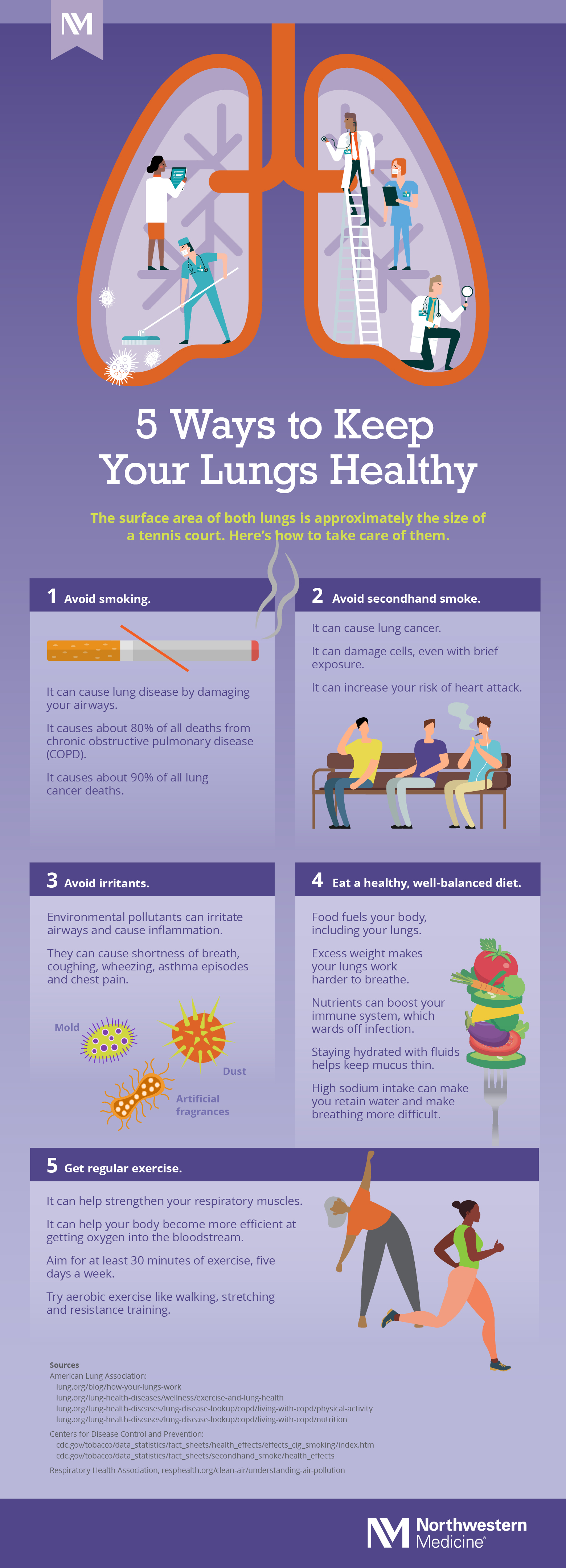Keep Your Lungs Healthy (Infographic)
Breathe Better
Published October 2020
The average person takes thousands of breaths a day. But, for some, each breath can be a struggle.
And although COVID-19 has raised more awareness of lung health and the toll disease can take on your lungs, a number of other conditions can also impact your lungs.
Common Lung Conditions
Some lung diseases are caused by bacterial, viral or fungal infections, while others may be associated with environmental factors. But they all prevent the lungs from functioning properly.
Asthma and chronic obstructive pulmonary disease (COPD) are the two most common respiratory conditions in the U.S., each affecting approximately 20 million people. Both conditions can make breathing difficult. Individuals with COPD may have emphysema or chronic bronchitis, or a combination of both conditions.
Acute bronchitis is a common type of respiratory infection. It occurs when inflammation in the lining of your bronchial tubes produces mucus that can cause a severe cough.
Another common respiratory infection is pneumonia, which can be caused by bacteria, viruses or fungi. Pneumonia is an infection of one or both of the lungs in which the air sacs fill with pus and other liquid. Left untreated, pneumonia can lead to acute respiratory distress syndrome (ARDS), or a severe form of respiratory failure.
“Lung abscesses can also occur as a result of pneumonia,” says Northwestern Medicine Thoracic Surgeon Samuel S. Kim, MD. “These are infected fluids that build around your lung and may require antibiotics or surgical intervention to clean the lung.”
Pneumonia can also cause pleural effusion, which is a build-up of fluid in the chest cavity outside of the lungs. Serious complications can include pulmonary edema, or fluid in the lungs.
About Lung Cancer
Lung cancer is the third most common cancer in the U.S. Smoking is the leading risk factor for lung cancer. However, environmental factors such as exposure to secondhand smoke, radon, asbestos and even air pollution can increase your risk as well.
Dr. Kim encourages individuals who are at high risk for lung cancer, such as those who actively smoke or have a history of smoking, to discuss lung cancer screening with their physician. “Northwestern Medicine is at the forefront of screening for lung cancer,” he says. “You may be eligible for a CT scan, which uses the lowest dose of radiation possible to detect lung nodules.”
If a lung nodule is detected, next steps may include active monitoring or a biopsy. Northwestern Medicine specialists use advanced technology for lung biopsy.
How to Protect Your Lungs
“The most important thing is knowing your risk for developing lung disease, such as smoking,” says Dr. Kim. “It’s important to touch base with your primary care physician because the sooner we find these things, the earlier we can intervene and make a difference in terms of survival.”
Dr. Kim also advises following a healthy diet and exercising your lungs regularly, and avoid using e-cigarettes.
“There is some sense of injury that comes with chemical inhalation. It tends to cause inflammation of the lungs, but to what degree is unknown,” he says. “If you put something that’s not intended to go into your body, like chemicals, it’s going to have consequences.”
Here are more ways to keep your lungs healthy.
 Download Keep Your Lungs Healthy (Infographic)
Download Keep Your Lungs Healthy (Infographic)







